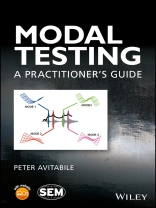The practical, clear, and concise guide for conducting experimental modal tests
Modal Testing: A Practitioner’s Guide outlines the basic information necessary to conduct an experimental modal test. The text draws on the author’s extensive experience to cover the practical side of the concerns that may arise when performing an experimental modal test. Taking a hands-on approach, the book explores the issues related to conducting a test from start to finish. It covers the cornerstones of the basic information needed and summarizes all the pertinent theory related to experimental modal testing.
Designed to be accessible, Modal Testing presents the most common excitation techniques used for modal testing today and is filled with illustrative examples related to impact testing which is the most widely used excitation technique for traditional experimental modal tests. This practical text is not about developing the details of the theory but rather applying the theory to solve real-life problems, and:
* Delivers easy to understand explanations of complicated theoretical concepts
* Presents basic steps of an experimental modal test
* Offers simple explanations of methods to obtain good measurements and avoid the common blunders typically found in many test approaches
* Focuses on the issues to be faced when performing an experimental modal test
* Contains full-color format that enhances the clarity of the figures and presentations
Modal Testing: A Practitioner’s Guide is a groundbreaking reference that treats modal testing at the level of the practicing engineer or a new entrant to the field of experimental dynamic testing.
Inhaltsverzeichnis
Preface
Part 1 – Overview of Experimental Modal Analysis using the Frequency Response Method
Chapter 1 Introduction to Experimental Modal Analysis – A Simple Non-Mathematical Presentation
Chapter 2 Theory Related to Experimental Modal Analysis
Chapter 3 Digital Signal Processing for Experimental Modal Testing
Chapter 4 Excitation Techniques – Impact and Shaker Excitation
Chapter 5 Modal Parameter Estimation Techniques
Part 2 – Practical Considerations for Experimental Modal Testing
Chapter 6 Test Setup Considerations
Chapter 7 Impact Testing Considerations
Chapter 8 Shaker Testing Considerations
Chapter 9 Estimating Modal Parameters
Chapter 10 General Considerations
Chapter 11 Tips, Tricks and Assorted Information including Checklists for Testing
Appendices
A Linear Algebra
B Example using Two DOF System – Eigensolution
C Example using Two DOF System – Poles, Residues, Frequency Response Functions
D Example using Three DOF System – Poles, Residues, Scaling Shapes, Frequency Response Functions
E Collection of Dynamic Systems Theory, Tutorials, GUIs and Assorted Information
F Some Summarizing Cliff Notes
Collection of Sets of Modal Data Collected for Processing
G Repeated Root Frame Impact Test with Boundary Condition Effects
H CSA RADARSAT Satellite MIMO Shaker test
I Demo Airplane Shaker Modal Test
J Whirlpool Dryer Cabinet Modal Test
K GM MTU Automotive Round Robin MIMO Modal Test
L Composite Spar Modal Test
M UML Base Upright Wing Modal Test
N Nomenclature
Index
Über den Autor
PETER AVITABILE is Professor Emeritus at the University of Massachusetts Lowell, the co-director of the Structural Dynamics and Acoustic Systems Laboratory, and the former President for the Society for Experimental Mechanics. In addition, he is the Associate Editor of the Handbook for Experimental Structural Mechanics. He has written hundreds of papers and articles on analytical and experimental modal analysis techniques, including the Modal Space article series published in SEM’s Experimental Techniques.












